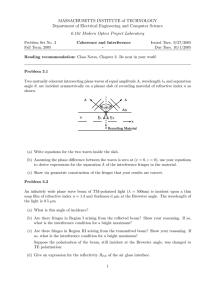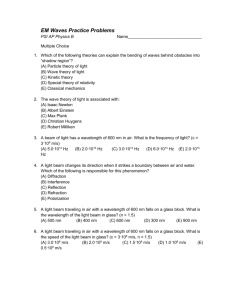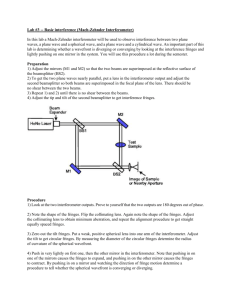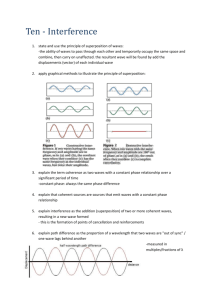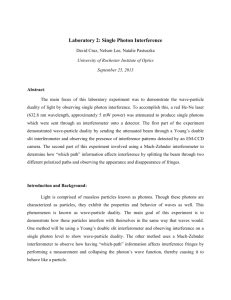EM Waves Practice Problems
advertisement
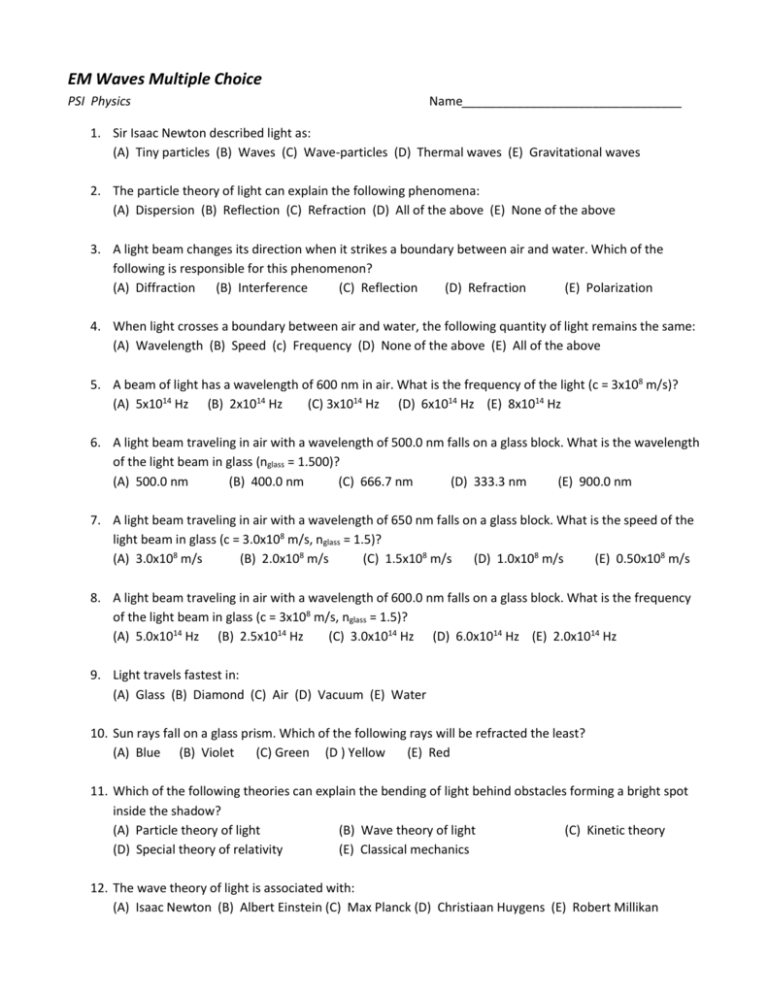
EM Waves Multiple Choice PSI Physics Name________________________________ 1. Sir Isaac Newton described light as: (A) Tiny particles (B) Waves (C) Wave-particles (D) Thermal waves (E) Gravitational waves 2. The particle theory of light can explain the following phenomena: (A) Dispersion (B) Reflection (C) Refraction (D) All of the above (E) None of the above 3. A light beam changes its direction when it strikes a boundary between air and water. Which of the following is responsible for this phenomenon? (A) Diffraction (B) Interference (C) Reflection (D) Refraction (E) Polarization 4. When light crosses a boundary between air and water, the following quantity of light remains the same: (A) Wavelength (B) Speed (c) Frequency (D) None of the above (E) All of the above 5. A beam of light has a wavelength of 600 nm in air. What is the frequency of the light (c = 3x108 m/s)? (A) 5x1014 Hz (B) 2x1014 Hz (C) 3x1014 Hz (D) 6x1014 Hz (E) 8x1014 Hz 6. A light beam traveling in air with a wavelength of 500.0 nm falls on a glass block. What is the wavelength of the light beam in glass (nglass = 1.500)? (A) 500.0 nm (B) 400.0 nm (C) 666.7 nm (D) 333.3 nm (E) 900.0 nm 7. A light beam traveling in air with a wavelength of 650 nm falls on a glass block. What is the speed of the light beam in glass (c = 3.0x108 m/s, nglass = 1.5)? (A) 3.0x108 m/s (B) 2.0x108 m/s (C) 1.5x108 m/s (D) 1.0x108 m/s (E) 0.50x108 m/s 8. A light beam traveling in air with a wavelength of 600.0 nm falls on a glass block. What is the frequency of the light beam in glass (c = 3x108 m/s, nglass = 1.5)? (A) 5.0x1014 Hz (B) 2.5x1014 Hz (C) 3.0x1014 Hz (D) 6.0x1014 Hz (E) 2.0x1014 Hz 9. Light travels fastest in: (A) Glass (B) Diamond (C) Air (D) Vacuum (E) Water 10. Sun rays fall on a glass prism. Which of the following rays will be refracted the least? (A) Blue (B) Violet (C) Green (D ) Yellow (E) Red 11. Which of the following theories can explain the bending of light behind obstacles forming a bright spot inside the shadow? (A) Particle theory of light (B) Wave theory of light (C) Kinetic theory (D) Special theory of relativity (E) Classical mechanics 12. The wave theory of light is associated with: (A) Isaac Newton (B) Albert Einstein (C) Max Planck (D) Christiaan Huygens (E) Robert Millikan 13. In Young’s double-slit experiment, a series of bright and dark lines was observed. Which of the following principles is responsible for this phenomenon? (A) Polarization (B) Reflection (C) Dispersion (D) Interference (E) Refraction 14. A blue beam of light falls on two narrow slits producing an interference pattern on a screen. If instead of blue light, a red beam of light was used in the same experiment, which changes to the interference pattern can be observed? (A) Interference fringes move closer to the central maximum. (B) Interference fringes move further away from the central maximum. (C) No change in interference. (D) Bright fringes are replaced with dark fringes. (E) The number of fringes increases. 15. In a Young’s double-slit experiment, an interference pattern is observed on a screen. The apparatus is then submerged into water. What is the change in the interference pattern? (A) No change in interference. (B) The number of fringes increases. (C) The fringes move closer to the central maximum. (D) The fringes move further away from the central maximum. (E) Bright fringes are replaced with dark fringes. 16. Two coherent light waves approaching a certain point on a screen produce a constructive interference pattern. The optical extra distance traveled by one of the waves is: (A) λ/2 (B) λ/3 (C) 3λ/2 (D) λ (E) 5λ/2 17. In a Young’s double-slit experiment the distance between the slits increases. What happens to the separation between the fringes? (A) Increases. (B) Decreases. (B) Stays the same. (D) Increases for the bright fringes and decreases for the dark fringes. (E) Increases for the dark fringes and decreases for the bright fringes. 18. In a double-slit experiment, the distance between the slits is doubled. What happens to the separation between the two adjacent maxima? (A) Doubles. (B) Quadruples. (C) Is cut in half. (D) Is cut to a quarter. (E) Stays the same. 19. A diffraction grating can be used to: (A) Analyze the intensity of a light beam. (B) Identify an element by its optical spectra. (C) Identify an element by its intensity. (D) Determine the speed of light. (E) All of the above. 20. A light beam spreads out when it travels through a narrow slit. Which of the following can explain this phenomenon? (A) Polarization (B) Reflection (C) Dispersion (D) Diffraction (E) Refraction 21. In a single-slit experiment, as a result of the interference of a laser beam, a student observes a set of red and dark concentric circles. When he increases the width of the slit, what happens to the interference pattern? (A) The separation between the circles increases. (B) The separation between the circles decreases. (C) No change in interference pattern. (D) The separation between the circles increases and then decreases. (E) The separation between the circles decreases and then increases. 22. Colors in a soap bubble or in an oil slick on the road are caused by: (A) Diffraction (B) Polarization (C) Thin Film Interference (D) Light intensity change 23. Maxwell’s Equations describe the integration of which two fundamental forces? (A) Electricity and Magnetism (B) Electricity and the Weak Nuclear force (C) Magnetism and the Weak Nuclear force (D) Magnetism and Gravity (E) Electricity and the Strong Nuclear force 24. Allowing only the Electric Field component vibrating in one, specific plane of an electromagnetic wave through a special filter is called: (A) Diffraction (B) Polarization (C) Interference (D) Refraction (E) Reflection 25. Which of the following is the correct order of electromagnetic radiation with increasing frequency? (A) Radio Waves, Visible Light, IR Radiation, UV Radiation, X-Rays, γ –Rays (B) γ –Rays, Visible Light, IR Radiation, UV Radiation, X-Rays, Radio Waves (C) Radio Waves, UV Radiation, Visible Light, IR Radiation, X-Rays, γ –Rays (D) Radio Waves, Visible Light, X-Rays, IR Radiation, UV Radiation, γ –Rays (E) Radio Waves, IR Radiation, Visible Light, UV Radiation, X-Rays, γ –Rays Answer Guide 1. A 2. D 3. D 4. C 5. A 6. D 7. B 8. A 9. D 10.E 11.B 12.D 13.D 14.B 15.C 16.D 17.B 18.C 19.B 20.D 21.B 22.C 23.A 24.B 25.E
